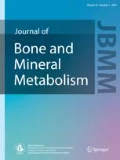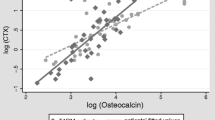Abstract
The purpose of the study was to investigate bone mineral density (BMD) in children with type 1 diabetes (DM1) and to establish the relationships between BMD, physical activity, glycemic control, and markers of systemic oxidative stress and inflammation. We studied 30 children with DM1, aged 4.7–18.6 years, and 30 healthy subjects, matched by sex, age, and body mass index (BMI). Mean duration of DM1 was 5.4 ± 3.4 years and mean glycosylated hemoglobin (HbA1c) level over 12 months was 9.8 ± 1.5%. Lumbar and total bone mineral density (BMD, g/cm2) were measured by dual-energy X-ray absorptiometry (DXA). We calculated the apparent volumetric lumbar BMD (BMDvol, g/cm3) and total mineral content adjusted for age and height (BMCadj), and measured plasma intercellular adhesion molecule-1 (ICAM-1), high sensitivity C-reactive protein (hs-CRP), and urinary 8-iso-prostaglandin F2a (F2-IsoPs). Calcium (Ca) intake was assessed by questionnaire and physical activity by questionnaire and accelerometer (ActiGraph, count/h). Total BMCadj and lumbar BMDvol were significantly lower in children with DM1 than in controls (101.8 ± 7.7 vs. 107 ± 5.7%, P = 0.005; 0.32 ± 0.08 vs. 0.36 ± 0.09 g/cm3, P = 0.05, respectively). These differences were mostly caused by the differences in boys. Plasma ICAM-1 and hs-CRP levels were significantly higher in the DM1 group compared to the controls. Ca intake and urine F2-IsoPs levels were similar between the groups. Diabetic boys were less active than controls (18231 ± 6613 vs. 24145 ± 7449 count/h, P = 0.04). In the DM1 group, lumbar BMDvol correlated inversely with urinary F2-IsoPs (r = −0.5; P = 0.005) and plasma ICAM-1 levels (r = −0.4; P = 0.02), and also with HbA1c levels after adjustment for age (r = −0.45; P < 0.05). Total BMCadj correlated inversely with HbA1c levels (r = −0.4; P = 0.02). We conclude that children with DM1, particularly boys, have lower BMD. Poor glycemic control, elevated markers of oxidative stress, and inflammation are associated with lower BMD.



Similar content being viewed by others
References
Vestergaard P (2007) Discrepancies in bone mineral density and fracture risk in patients with type 1 and type 2 diabetes: a meta-analysis. Osteoporos Int 18:427–444
Gunczler P, Lanes R, Paoli M, Martinis R, Villaroel O, Weisinger JR (2001) Decreased bone mineral density and bone formation markers shortly after diagnosis of clinical type 1 diabetes mellitus. J Pediatr Endocrinol Metab 14:525–528
Léger J, Marinovic D, Alberti C, Dorgeret S, Chevenne D, Marchal CL, Tubiana-Rufi N, Sebag G, Czernichow P (2006) Lower bone mineral content in children with type 1 diabetes mellitus is linked to female sex, low insulin-like growth factor type I levels, and high insulin requirement. J Clin Endocrinol Metab 91:3947–3953
Salvatoni A, Mancassola G, Biasoli R, Cardani R, Salvatore S, Broggini M, Nespoli L (2004) Bone mineral density in diabetic children and adolescents: a follow-up study. Bone (NY) 34:900–904
Moyer-Mileur L, Dixon S, Quick J, Askew E, Murray M (2004) Bone mineral acquisition in adolescents with type 1 diabetes. J Pediatr 145:662–669
Heap J, Murray MA, Miller SC, Jalili T, Moyer-Mileur LJ (2004) Alterations in bone characteristics associated with glycemic control in adolescents with type 1 diabetes mellitus. J Pediatr 144:56–62
Pascual J, Argente J, Lopez MB, Muñoz MB, Martinez G, Vazquez MA, Jodar E, Perez-Cano R, Hawkins F (1998) Bone mineral density in children and adolescents with diabetes mellitus type 1 of recent onset. Calcif Tissue Int 62:31–35
De Schepper J, Smitz J, Rosseneu S, Bollen P, Louis O (1998) Lumbar spine bone mineral density in diabetic children with recent onset. Horm Res 50:193–196
Liu EY, Wactawski-Wende J, Donahue RP, Dmochowski J, Hovey KM, Quattrin T (2003) Does low bone mineral density start in post-teenage years in women with type 1 diabetes? Diabetes Care 26:2365–2369
Bechtold S, Putzker S, Bonfig W, Fuchs O, Dirlenbach I, Schwarz HP (2007) Bone size normalizes with age in children and adolescents with type 1 diabetes. Diabetes Care 30:2046–2050
Brownlee M (2000) Negative consequences of glycation. Metabolism 49:9–13
Joussen AM, Murata T, Tsujikawa A, Kirchhof B, Bursell SE, Adamis AP (2001) Leukocyte-mediated endothelial cell injury and death in the diabetic retina. Am J Pathol 158:147–152
Lin J, Glynn RJ, Rifai N, Manson JE, Ridger PM, Nathan DM, Schaumberg DA (2008) Inflammation and progressive nephropathy in type 1 diabetes mellitus in the diabetes control and complications trial (DCCT). Diabetes Care 31:2338–2348
Heilman K, Zilmer M, Zilmer K, Lintrop M, Kampus P, Kals J, Tillmann V (2009) Arterial stiffness, carotid artery intima-media thickness and plasma myeloperoxidase level in children with type 1 diabetes. Diabetes Res Clin Pract (in press)
Warner JT, Cowan FJ, Dunstan FD, Evans WD, Webb DK, Gregory JW (1998) Measured and predicted bone mineral content in healthy boys and girls aged 6–18 years: adjustment for body size and puberty. Acta Paediatr 87:244–249
Kröger H, Vainio P, Nieminen J, Kotaniemi A (1995) Comparison of different models for interpreting bone mineral density measurements using DEXA and MRI technology. Bone 17:157–159
Godin G, Shepard RJ (1985) Simple methods to assess exercise behaviour in the community. Can J Appl Sport Sci 10:141–146
Krakauer J, McKenna M, Burderer N, Rao D, Whitehouse F, Pafitt A (1995) Bone loss and bone turnover in diabetes. Diabetes 44:775–782
Matkovic V, Jelic T, Wardlaw GM, Ilich JZ, Goel PK, Wright JK, Andon MB, Smith KT, Heaney RP (1994) Timing of peak bone mass in Caucasian females and its implication for the prevention of osteoporosis. Inference from a cross-sectional model. J Clin Invest 93:799–808
Tillmann V, Adojaan B, Shor R, Price DA, Tuvemo T (1996) Physical development in Estonian children with type 1 diabetes. Diabet Med 13:97–101
Rohrer T, Stierkorb E, Heger S, Karges B, Raile K, Schwab KO, Holl RW, Diabetes-Patienten-Verlaufsdaten (DPV) Initiative (2007) Delayed pubertal onset and development in German children and adolescents with type 1 diabetes: cross-sectional analysis of recent data from the DPV diabetes documentation and quality management system. Eur J Endocrinol 157:647–653
Camurdan MO, Ciaz P, Bidezi A, Demirel F (2007) Role of hemoglobin A(1c), duration and puberty on bone mineral density in diabetic children. Pediatr Int 49:645–651
Tillmann V, Darlington ASE, Eiser C, Bishop NJ, Davies HA (2002) Male sex and low physical activity are associated with reduced spine bone mineral density in survivors of childhood acute lymphoblastic leukemia. J Bone Miner Res 17:1073–1080
Awad JA, Morrow JD, Takahashi K, Roberts LJ (1993) Identification of non-cyclooxygenase-derived prostanoid (F2-isoprostane) metabolites in human urine and plasma. J Biol Chem 268:4161–4169
Wang Z, Ciabattoni G, Créminon C, Lawson JA, FitzGerald GA, Patrono C, Maclouf J (1995) Immunological characterization of urinary 8-epi-PGF2 excretion in man. J Pharmacol Exp Ther 275:94–100
Morrow JD, Roberts LJ (1996) The isoprostanes: current knowledge and directions for future research. Biochem Pharmacol 51:1–9
Flores L, Rodela S, Abian J, Clària J, Esmatjes E (2004) F2 isoprostane is already increased at the onset of type 1 diabetes mellitus: effect of glycemic control. Metabolism 53:1118–1120
Davì G, Chiarelli F, Santilli F, Pomilio M, Vigneri S, Falco A, Basili S, Ciabattoni C, Patrono C (2003) Enhanced lipid peroxidation and platelet activation in the early phase of type 1 diabetes mellitus. Role of interleukin-6 and disease duration. Circulation 107:3199–3203
Mody N, Parhami F, Sarafian TA, Demer LL (2001) Oxidative stress modulates osteoblastic differentiation of vascular and bone cells. Free Radic Biol Med 31:509–519
Bai XC, Lu D, Bai J, Zheng H, Ke ZY, Li XM, Luo SQ (2004) Oxidative stress inhibits osteoblastic differentiation of bone cells by ERK and NF-kappaB. Biochem Biophys Res Commun 314:197–207
Chen RM, Wu GJ, Chang HC, Chen JT, Chen TF, Lin YL, Chen TL (2005) 2, 6-Diisopropylphenol protects osteoblasts from oxidative stress-induced apoptosis through suppression of caspase-3 activation. Ann N Y Acad Sci 1042:448–459
Fatokun AA, Stone TW, Smith RA (2007) Hydrogen peroxide mediates damage by xanthine and xanthine oxidase in cerebellar granule neuronal cultures. Neurosci Lett 416:34–38
Hamada Y, Kitazawa S, Kitazawa R, Fujii H, Kasuga M, Fukagawa M (2007) Histomorphometric analysis of diabetic osteopenia in streptozotocin-induced diabetic mice: a possible role of oxidative stress. Bone (NY) 40:1408–1414
Basu S, Michaëlsson K, Olofsson H, Johansson S, Melhus H (2001) Association between oxidative stress and bone mineral density. Biochem Biophys Res Commun 288:275–279
McCabe LR (2007) Understanding the pathology and mechanisms of type 1 diabetic bone loss. J Cell Biochem 102:1343–1357
Acknowledgments
This study was funded by Estonian Science Foundation Grant Nr. 6588, the targeted financed grants SF0182695s05 and SF0180105s08 from the Ministry of Science and Education. Support was also given by the European Union through the European Regional Development Fund.
Author information
Authors and Affiliations
Corresponding author
About this article
Cite this article
Heilman, K., Zilmer, M., Zilmer, K. et al. Lower bone mineral density in children with type 1 diabetes is associated with poor glycemic control and higher serum ICAM-1 and urinary isoprostane levels. J Bone Miner Metab 27, 598–604 (2009). https://doi.org/10.1007/s00774-009-0076-4
Received:
Accepted:
Published:
Issue Date:
DOI: https://doi.org/10.1007/s00774-009-0076-4



